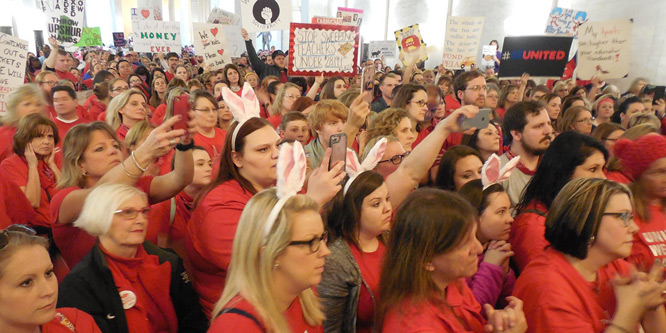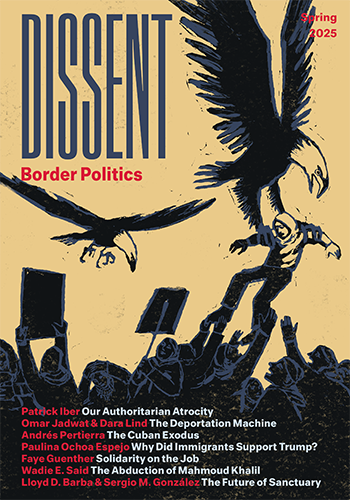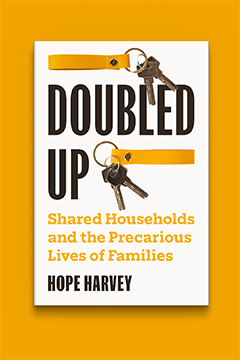West Virginia Teachers Walk Out
West Virginia Teachers Walk Out
Walking off the job for the first time in nearly thirty years, West Virginia teachers are channeling the spirit of their state’s historic, militant labor movement.

When Logan County special education teacher Leah Clay Stone entered the West Virginia capitol building on February 2, she saw a sea of teachers from the chamber doors of the Senate and House all the way back to the rotunda. Her county was part of the first work stoppage this month that saw public school teachers flock to the capitol building in Charleston to protest continued low wages, spiking insurance premiums, and poor working conditions.
The teachers flooding the galleries that day came from schools in just three counties. But since February 2 the rebellion has spread. Today marks the second day of a statewide work stoppage, with schools closed in all fifty-five counties. The teachers—who don’t even have legal collective bargaining—wear red T-shirts with the outline of West Virginia and the word UNITED emblazoned across them, a visual that calls to mind not only the Chicago teachers’ strike of 2012 but also the Wisconsin capitol occupation in 2011, against Governor Scott Walker and the Republican legislature’s move to take away collective bargaining rights from the state’s public employees. Now West Virginia public employees are showing that even without collective bargaining rights, they too can make a heck of a lot of noise.
On Thursday morning, thousands of teachers headed to the capitol, carpooling because the walkout included bus drivers. Others stayed close to home to make sure they had a presence in their schools, where they were met with support from students and parents. That support has been building over recent weeks: Ashlea Bassham’s ninth- and tenth-grade students and others had already held their own walkout in Logan County, wielding signs that read “I’m in the bleachers for my teachers.” Parents have held informational pickets and walk-ins, standing outside schools in the cold and the snow to support the teachers. The movement has spread from county to county, neighbor to neighbor, as teachers who live in one county and work in another talk to friends at home and on the job. “It literally was like a fire just catching and going,” says Stone, who is the local vice-president for the Logan County Education Association, one of the two associations in the state.
At the beginning of the legislative session, the executive committee of the association called an emergency meeting to discuss changes to their insurance plan and other bills being introduced in the legislature. The teachers called for a vote to walk out. “I don’t think there was anybody still seated. It was a resounding yes,” Stone said. She then put her production-management background to use pulling together a voting process, getting representatives from every school to collect ballots. “We managed to get ballots into every school and all three bus garages and had them back into my hands and counted in twenty-four hours,” she said. “I literally was creating a ballot as I was walking out the door of the building. I was like ‘somebody else needs to drive, I need to take care of this.'”
The teachers were trying to avoid the district getting an injunction to halt their action, but instead the superintendent closed the schools, a pattern that would repeat itself in every county across the state as teachers stood up to join the statewide day of action. A movement organized by teachers on the ground was able to spread in part through existing networks, in part through social media. “A lot of people blame Facebook for all the bad things in 2016 with the election, but it has actually been really helpful here because West Virginia is so rural and spread out,” said Jay O’Neal, who teaches in Charleston.
Like other teachers who have resorted to stopping work in recent years, the West Virginia teachers have emphasized that their goal is to make education better for every child in West Virginia. “Teachers’ working conditions are students’ learning conditions” has become the byword in these campaigns. The West Virginia teachers have demonstrated this commitment not only with their demands—for filling teacher vacancies, for smaller class sizes—but with immediate action. “As soon as we called the work stoppage for Thursday and Friday our locals took it upon themselves to start working with churches and food banks and different places to provide day care for the parents who needed it, to provide meals for the many students who get their hot meals at school,” said Dale Lee of the West Virginia Education Association (WVEA).
The legislature and the board of the Public Employees Insurance Agency (PEIA) have begun to make some noises about conceding some to the teachers’ demands, but nothing is concrete and the work stoppage is set to continue at least through Monday.
The teachers began to notice trouble in January, right at the beginning of the legislative session. In that first session, Bassham noted, there were over thirty bills introduced that seemed ominous. When it comes to salaries, West Virginia teachers are already some of the worst off in the country—forty-eighth, according to Lee—and their health-insurance premiums had increased so much over the last year that it amounted to a pay cut. “I keep seeing this number thrown around—$45K is the average teacher salary. I’ve been teaching for seven years and I am nowhere near that,” Stone said. O’Neal added, “I moved here in 2015 and my second year teaching, I made less than my first.”
That pay cut came from a change to how PEIA insurance was calculated—it shifted from being based on the individual teacher’s income to total family income. That could effectively double the already-high premiums for insurance that used to be seen as a counterbalance to low wages. On top of that, the teachers would be penalized if they did not participate in a wellness program.
Those issues already left teachers feeling undervalued and disrespected. And that came on top of legislators proposing bills that threatened public education—such as introducing charter schools, “education savings accounts” (giving parents public funds to spend on educating their children, or a “backdoor voucher” in Lee’s words), so-called “paycheck protection,” which restricts the ability for automatic deduction of union dues, and other attacks on the already deeply restricted unions. Anger at the anti-union proposals opened the door to bring up other issues that had been frustrating teachers for much longer, like sky-high class sizes in secondary schools and a lack of electives for students.
Despite it all, Lee noted, “We have great schools. We’re right at 90 percent graduation rate, and for a rural state that is exceptional.” To him, legislators’ complaints about spending are disingenuous—the state is paying for past underfunding of retirement benefits and counting those dollars as education spending. Because West Virginia’s population is quite spread out, that also means that transporting students costs more than it would in more densely populated states—more dollars that aren’t going to the classroom but are still necessary to spend.
Meanwhile the state has a shortage of certified teachers because it’s hard to convince people to enter a job when starting salaries for people with advanced degrees are still in the $30–35,000 range. “You’re sold the idea of, hey, go to college, get a degree, get an advanced degree, and then you still really can’t make ends meet,” Bassham said. “Obviously we do it because we like the kids, but I also like to be able to pay my bills and not have $8 to last me six days until payday.”
Leah Clay Stone is a second-generation member of the West Virginia Education Association (WVEA)—she walked picket lines with her mother during a 1990 teacher strike. Her father was a coal miner through the 1980s. West Virginia is a state with a proud labor history that gets lost in the “Trump Country” profiles. Many of the teachers in today’s fight have personal experiences like Stone’s. It was not lost on anyone I spoke with that the first teachers to stop work were from coal country, from Mingo and Logan Counties, the sites of the great mine wars.
Stone also recalls, as a teenager, going to party with friends on top of the infamous Blair Mountain, the site of what historian Elizabeth Catte, in her new book What You Are Getting Wrong About Appalachia, calls “the largest show of armed resistance in the United States since the Civil War—and the most significant labor uprising in the United States.” Immortalized in part in the 1987 movie Matewan and in memorable labor ballads, the Battle of Blair Mountain pitted workers and their allies—like venerable labor agitator Mary Harris “Mother” Jones—against a “private army” that would later be praised by the National Rifle Association (yes, the same one that currently wants to arm teachers against school shooters). It is a stark reminder that West Virginians died to organize the unions that the state’s officials are currently bad-mouthing in the press.
Today’s action is the first statewide walkout of teachers in almost thirty years. “If you look at what teachers and their allies are posting on social media, you can see that they are connecting the upcoming action to the state’s important history of labor uprising, from Blair Mountain to Widen.” Elizabeth Catte told me via email. She pointed to a tweet from Richard Ojeda, a candidate for Congress from the state, who posted a photograph of himself in a red bandanna with the caption, “The term redneck started when WV coal miners tied red bandanas around their necks during the bloody battle of Blair mountain to unionize. Today, our teachers channeled their history. #UnionStrong”
“It’s rather impressive to me that people don’t have the knowledge of what it means to be union proud. Or what it means to be involved in an organization,” Stone, who recalled doing a school project on Mother Jones, said. “For the past few years we’ve struggled to keep membership even in our organization. But in this moment and this movement people have been finding out that they are the movement. If they want something done they have to speak up.”
These days, of course, the labor movement is a shadow of its former self in terms of both militancy and membership. With collective bargaining banned for West Virginia teachers and public-sector workers, unions are voluntary associations—meaning that teachers at any given school might be members of the WVEA or the American Federation of Teachers-West Virginia (AFT-WV), or neither. Without collective bargaining, the WVEA’s Dale Lee explained, mostly the associations fight to get work issues that unions might bargain over—like duty-free lunches and planning periods—written into state law.
There is a separate association for school service personnel, the West Virginia School Service Personnel Association, who have also backed the job action—cooks, custodians, maintenance workers, and bus drivers. Beyond that, Bassham told me, they are standing for all public employees who are struggling. “It’s not just a teacher issue, it’s not just a school issue, it’s our state not wanting to take care of the people who are trying to make our state a better place.”
Their message is a reminder that despite pollsters’ tendency to make a college degree the dividing line between “working” and “middle” class, the categories are often not so clear cut. The reality is that college-educated workers too have to fight for decent wages and benefits. That the teachers all cite Blair Mountain’s miners as inspiration is an act of class solidarity and a reminder that the so-called knowledge economy we have been told to prize over manual labor doesn’t come with a guarantee of good pay any more than coal mining did.
West Virginia’s government has long been dominated by coal and other extractive industries. In fact its sitting governor, Jim Justice, is a second-generation coal tycoon and a billionaire who owes his own state millions in back taxes. But Jay O’Neal is heartened that teachers and their supporters—including the mine workers’ union—are now calling for raising taxes on those extractive companies in order to fund education. In a literal sense, the teachers are fighting the same companies that the coal miners were, decades ago.
On Thursday teachers from all three education workers’ associations took to the streets and the capitol halls, dressed in red, bearing handmade signs, some of them wearing those red bandannas. They waved to passing drivers and marched with other unionists. Schools throughout the state remained shuttered Friday, and at an afternoon press conference, union representatives said they were prepared to continue the walkout until the state commits to address their demands: higher pay, fully funded insurance benefits, and rejection of the regressive bills.
Teachers had already driven to the capitol on snow days, on treacherous mountain roads. “Our colleagues in the northern panhandle and the eastern panhandle have to come so much further,” Bassham said. “They drove on some crazy mountain roads to holler at legislators, and it was fabulous.”
Those legislators are slowly beginning to take action, Stone said, though there is also “quite a bit of grandstanding. . . . They want you to think that they’re doing everything they can for you but their voting record doesn’t show that.”
Public-employee strikes in West Virginia, as state Attorney General Patrick Morrisey has stated, are illegal. And yet the teachers have gone out anyway, taking the risk because it can’t get much worse for them. With the Janus case looming before the Supreme Court, potentially decimating every public-sector union in the nation, and right-wing governors looking for additional ways to punish unions, the West Virginia teachers’ situation is a bellwether.
These teachers recall that there were no laws protecting the mine workers in the 1920s either. Stone said, “West Virginians have a long background of doing what’s expected until it gets to be too much, and then we make sure we do what’s right, and we really want our legislators to do what’s right instead of what’s expected.”
Mother Jones would be proud.
Sarah Jaffe is the co-host of Dissent magazine’s Belabored podcast and the author of Necessary Trouble: Americans in Revolt.





